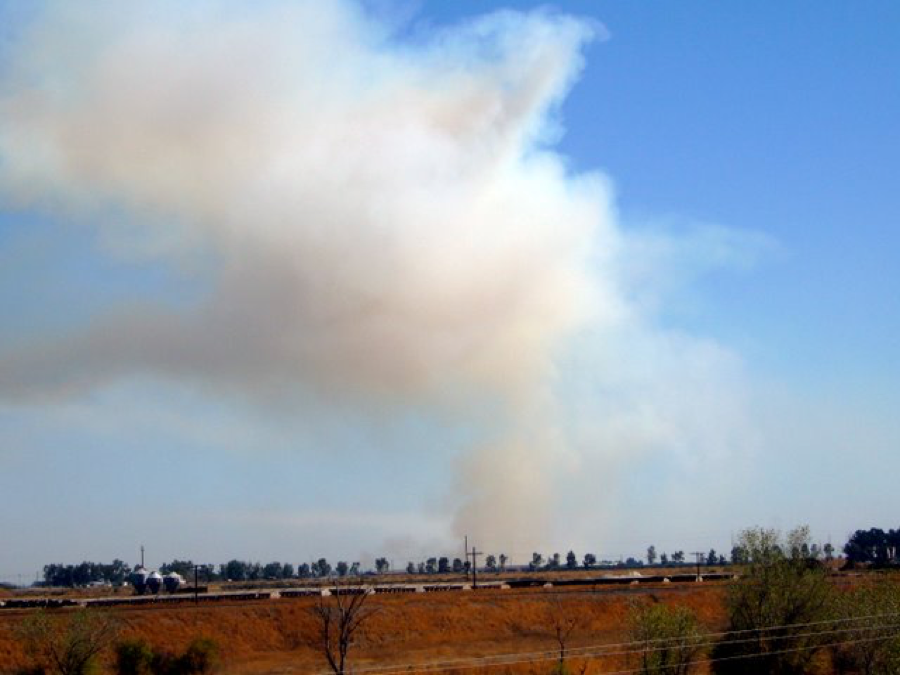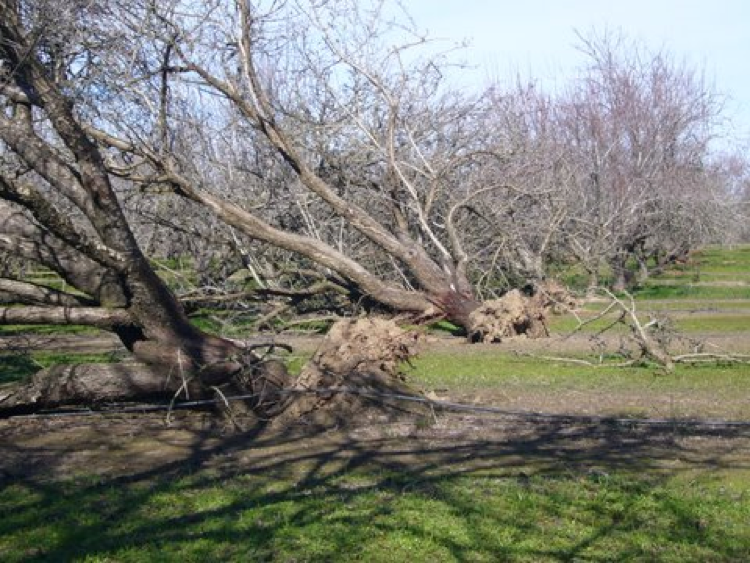2009 Almond Pollination Outlook
2009 Almond Pollination Outlook
Randy Oliver
ScientificBeekeeping.com
First published in ABJ November 2008
This is again the time of year when beekeepers want someone to look into the crystal ball and make predictions about the upcoming pollination season. No one that I know of has such a clairvoyant device, but we can certainly discuss the potential effects of factors involved this year.
Few sights are as beautiful to a beekeeper as an almond orchard in full bloom on a sunny winter day! Photos by the author.
Last February the growers got lucky. Despite widespread colony collapses, barely enough bees got set in the orchards to take advantage of the good flight weather during bloom. And despite early wind damage, and a later chilling frost, the trees produced yet another record yield! The market is now flush with a crop of rather small nuts, as the trees begin to show the strain of three consecutive heavy harvests.
So let’s look at the factors involved in the supply and demand market that sets almond prices. There are some potential changes for next year—some fairly predictable, some are wildcards. First, we’ll look at the demand side from the growers’ perspective, which is based upon the profitability of growing almonds.
Almonds enjoy privileged status as a premium nutmeat, both for flavor, and for their health image due to their content of vitamin E and mono-unsaturated fats. Indeed, US domestic per capita consumption doubled between 1999 and 2007!
Smoke from a warehouse fire in Orland, California, September 23 that destroyed some $10 million dollars worth of stored almonds. That’s a lot of nuts, but only a minute fraction of the massive crop of nearly a billion and a half pounds.
In the world market for nutmeats, growers have benefited from the weak dollar, which has helped with shipments to lucrative foreign markets (which account for nearly two thirds of sales). These growing overseas sales have a robust future, due the Almond Board’s legendary promotion of almonds (funded by a by a 3¢ “checkoff” for each pound of almonds entering the marketplace), and to rising personal incomes in developing countries.
However, the large harvest will likely soften the price a bit, especially for smaller nutmeats. But there is no sign of the growers’ greatest fear, which would be a nosedive in almond prices due to overproduction. Such an event is unlikely for the foreseeable future, as the Almond Board can recommend in any year that excess nuts be diverted to a “reserve” in order to support prices. This provision has not been necessary for several years, since there has been minimal “carry-in” of nuts from the previous harvest for several years, despite the record crops.
A reasonable price for nutmeats is good news in two ways: it means that growing almonds will still be profitable for growers, yet not turn away buyers due to excessively high prices. However, it will not be too profitable for the growers, since their production costs are skyrocketing. Profitable operations are willing to pay for good bees, but expect growers to be watching every penny!
The planting of almonds has greatly slowed of late, which may allow the bee industry to catch up with demand in the future. However, due to heavy planting in previous years, there will be an expected net additional 30,000 or so acres of trees coming into production this coming season (this figure may vary greatly depending upon the number of trees pulled due to water supply or other issues).
Old almond trees blown over by the January wind blast. Many of these old orchards have been, or will be, pulled from production this year. Some will be replanted with more densely-spaced almonds, others into more wind-hardy walnuts.
Crystal Ball: The long-term outlook for nut sales looks good, especially as long as the dollar remains relatively weak compared to foreign currencies. Profitable orchards support the demand for bees for pollination. There will likely still be a net increase in acreage, but the headlong expansion of almond plantings has slowed.
The agricultural side does not look quite as rosy. I mentioned earlier that there have been three consecutive record crops. Almond trees, like other organisms, need a rest from time to time. The question is whether they will hold back next year. If the bloom looks weak, or if growers expect a short crop, they may cut back on pollination demand. This will be especially true for growers who are unable to purchase water for the critical post-harvest irrigations this fall. This irrigation is critical to prepare the trees for a good bloom come February.
And this brings us to the water issue—the 800-lb gorilla! California is a thirsty state suffering from drought. I drove up the South Valley at harvest time, and simultaneously saw trees so laden with nuts that their branches had to be propped up, yet nearby orchards brown and dying due to lack of irrigation! Unless California gets major rain, some growers (even in North Valley) will be forced to either buy exorbitantly expensive water, or cut back on irrigation. In either case, this would force down the demand for bees, as growers either forego a crop, pull trees, or do not have the money to pay for multiple colonies per acre.
The second factor is fuel costs. Five dollar diesel hurts both farmers and beekeepers. It adds a few dollars per colony for a trip to and from the Midwest, and crimps the grower’s budget for bee pollination. High fuel costs also add to the sale price for nutmeats, which then effect market demand.
Now how about the supply of bees? Many beekeepers, due to supplemental feeding or good honeyflows, report strong colonies. A number of beekeepers made increase this spring, only to later combine their colonies when a good honeyflow, coupled with a high price for honey, materialized. But some areas, such as the Southeast, have experienced drought or flooding, and beekeepers there are struggling. Many beekeepers reported queenlessness problems this summer. It is too early at the time of this writing to see if there will be the sort of colony collapses experienced the past two seasons.
Some local boys dropping off bees before bloom last winter. Not all bees are hauled into the orchards on semis! Some are even hand unloaded.
The price of honey has finally climbed to a level where honey production is again profitable. This will likely dry up a part of the supply of bees as out-of-state honey producers go into the black, realize that they don’t need to go through the hassle of hauling bees to California, and simply stay home. Some who found out that the streets of California are not lined with gold are fearful of gambling on the trip west again. Many out-of-state beekeepers have no direct relationship with the growers, and have no compunction against not returning to the orchards that they pollinated last year.
This brings up the “Elk Hunting Factor” (from a Joe Traynor newsletter). Beekeepers are not afraid of hard work, and generally enjoy the challenge of the business. But the challenge has become a tedium these last few years as we work more and more days to keep our colony numbers up. Many of us longingly remember such niceties as days off and vacations (the elk hunting). It is becoming harder and harder to rationalize such hard work if we’re not making a profit. Brokers are finding that they need to pay beekeepers more to get them to supply the strong colonies desired by growers (yes, recent research by Dr. Frank Eischen confirms that an 8-frame colony collects twice as much, and a 12-framer three times as much, pollen as a 4-framer).
As you can see, my Crystal Ball is a bit cloudy—there are just too many unknowns at this time. So much hinges on the water supply and number of healthy, strong colonies available come midwinter. If the prices of honey and diesel remain high, heavy colony losses occur, and California gets some rain, expect the rental price per colony to rise. If the inverses occur, prices will likely hold steady. The buzz that I’m hearing, though, is that the general expectation is that colony rental prices will likely rise a bit. This is of course speculation, and only time will truly tell.
Nosema ceranae update: I’ve discussed with Dr. Higes my observation that some colonies appear to be able to thrive with low-level N. ceranae. He feels that colonies can handle moderate infections as long as the queen is able to sustain egglaying to offset the continued premature death of infected foragers. Collapse may not occur for months, or maybe more than a year after the colony becomes infected. A new young queen, or supersedure queen, may give the colony a “second wind,” but if the queen begins to fail, the colony will succumb. Surprisingly, N. ceranae does not appear to infect queen bees unless the infection level in the colony is quite high. His recent studies (in Spain) have found that during the period of inapparent infection, colonies may exhibit a 50-70% loss of honey production.







